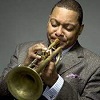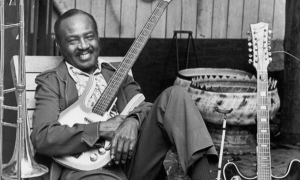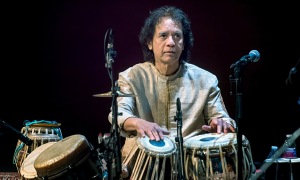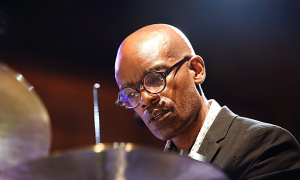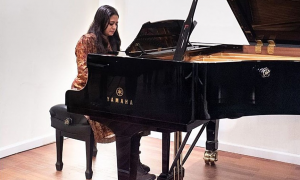Home » Jazz Articles » Under the Radar » A Different Drummer, Part 5: Terri Lyne Carrington
A Different Drummer, Part 5: Terri Lyne Carrington

Courtesy C. Andrew Hovan
When I was about 18, Jack DeJohnette and myself would play duos with him on piano and me on drums. He told me not to repeat what I heard. And instead, compliment it. That was great advice that I still think about today.
—Terri Lyne Carrington
Pioneers
In her book American Women in Jazz: Their Words, Lives and Music (Wideview Books, 1982), Sally Placksin highlights musicians by decade. She begins her timeline at 1900 but doesn't unearth early women drummers until four decades into her account. Bridget O'Flynn was born in Berkeley, California, in 1923 and taught herself to play drums as a child. Her mother promptly enrolled her in a school for "incorrigible" girls, but O'Flynn persisted. She openly fought against the marginalized role of women in jazz, first playing in an all-female band and later with Mary Lou Williams. A prominent critic called her the "female Krupa" after a 1943 New York City club date. She recorded lightly with Williams, appearing on three sessions in 1946-47. O'Flynn favored a subtle approach, often using only brushes. Her disappointment at the negative response to mixed-race bands, and a personal tragedy, led her to leave the music business.Drummer Rose Gottesman also played with Mary Lou Williams during the mid-1940s and with an all-woman band, the Hip Chicks. She was influenced by the drummers she heard at Harlem's Apollo Theater in the 1930s and sat in with the Savoy Sultans at the ballroom on Lenox Avenue in Harlem. Like O'Flynn, her career was brief—about three years. Viola Smith (1912 —2020) was the best-known woman drummer of the swing era and beyond. She lived to the age of one-hundred-seven and reportedly played on occasions into 2019. Smith was notable for her speed and a kit that included a dozen drums. She founded The Coquettes as an offshoot of her Wisconsin family's all-female band, including her seven sisters. Smith's work was not well documented, but she appeared on television, in films, and on Broadway along with her jazz group. Pauline Braddy (1922—1996) was the only drummer in the International Sweethearts of Rhythm, an integrated, all-female band, from 1939 to 1955. Known as "Queen of the Drums," Francis Davis, the renowned jazz critic of The Village Voice, noted that it was her playing that powered the popular swing orchestra.
Modern Women Drummers
Dottie Dodgion began playing professionally beginning in the 1950s. She worked with Marian McPartland, Eddie Gomez, Billy Mitchell, Zoot Sims, and others. New York drummer/percussionist Sue Evans played in cross-genre settings that included Judy Collins, the Brooklyn Philharmonic, and Aretha Franklin. In the jazz world, Evans worked with Gil Evans, Roswell Rudd, Sadao Watanabe, Hubert Laws, Randy Brecker, David Sanborn and Terence Blanchard. Billie Davies is a drummer/composer best known for her avant-garde compositions and her improvisational drumming techniques. Cindy Blackman Santana Santana has recorded several jazz albums as a leader and has performed with Pharoah Sanders, Sonny Simmons, Ron Carter, Sam Rivers, Cassandra Wilson, Bill Laswell, Joe Henderson, as well as numerous rock artists.Sherrie Maricle played clarinet and then cello before seeing Buddy Rich perform when she was in sixth grade. She completed a Master's of Arts in Jazz Performance in 1986 and a Doctorate of Philosophy in Jazz Performance/Composition in 2000. In the late 1980s, she was appointed director of percussion studies at NYU. Maricle leads the DIVA Jazz Orchestra, the DIVA Jazz Trio and teaches on the jazz faculty of the New York State Summer Music Festival. In 2009, she received the Lifetime Achievement Award at the Mary Lou Williams Women in Jazz Festival. Los Angeles native Kimberly Thompson began playing drums at the age of ten. She graduated from the Manhattan School of Music in 2003 with a bachelor's degree in jazz composition. She has recorded six albums as a leader and one supporting Kenny Barron. Her Treasures Abound (A Tribute to the Jazz Greats) (Self Produced, 2016) features her energetic drumming and original jazz songs written and performed with her quartet. One of the best known of current women percussionist/composers is Susie Ibarra. The Los Angeles area native has worked across media and genres from jazz to opera. She is also active as an educator, and documentary filmmaker.
We can see a full spectrum of musical interests in this small sampling of women drummer/percussionists. The selection would be more wide-ranging were it not for the misogynistic nature of the jazz world, reflecting flagrant historic ills of broader society. Among the most talented and extensively accomplished modern percussionists in jazz is Medford, Massachusetts native Terri Lyne Carrington. Her talents earned her a full scholarship to Berklee College of Music at the age of 11. In early 2021, I interviewed Ms. Carrington for the AAJ series on drummers and drumming.
Terri Lyne Carrington
Terri Lyne Carrington is a drummer, composer, producer, and educator. Among the many notable figures she has worked with are Greg Osby, Pharoah Sanders, Dizzy Gillespie, Stan Getz, Wayne Shorter, Lester Bowie and Herbie Hancock with whom she toured for ten years. Carrington has won three Grammys and is a professor at her alma mater, Berklee College of Music, where she serves as Founder and Artistic Director of the Berklee Institute of Jazz and Gender Justice. She is a member of several boards, including the Board of Trustees for The Recording Academy. Early in her career, Carrington led late-night television house bands for Arsenio Hall and Quincy Jones. As a leader/co-leader, she has recorded more than a dozen albums featuring artists such as Geri Allen, Ingrid Jensen, Aruán Ortiz, and Esperanza Spalding. Carrington has appeared as a side-woman on dozens of releases. Other projects have included partnerships in visual arts and choreography.All About Jazz: Could you tell me about where you grew up and what were your earliest musical influences?
Terri Lyne Carrington: I grew up in Medford, Massachusetts and my earliest musical influences were the people my father listened to, the records he played. A lot of it was blues-based jazz, people like Gene Ammons, Jack McDuff, Jimmy Smith, Les McCann... But also people like Illinois Jacquet and Rahsaan Roland Kirk. Rahsaan was the first person to let me sit in with him playing tambourine and singing "Volunteered Slavery." Clark Terry was also an early influence. My first professional gig was with him; he's always been a wonderful mentor and champion for young musicians.
AAJ: What was the first instrument you studied, and when were you introduced to drumming?
TLC: My first instrument was saxophone, but I did not have formal lessons. I was playing by ear until seven years old when I switched to drums. My grandfather was a drummer and passed away right before I was born, but his drums were in the house, and my dad would set them up sometimes to play them. My dad played saxophone as well, so music was always a big part of our family, and I benefited from their relationships. It allowed me access to amazing musicians and the jazz stage figuratively and literally.
AAJ: Women drummers are a rarity, and you're likely the best-known since Viola Smith. What is it about drumming that appeals to you?
TLC: I never really thought about why the drums appeal to me; it's just what I do. I imagine when I started, it was because it was fun, and it has stayed fun for the most part. But for me, it's like breathing, something that I am very much connected with and don't see as separate from myself. I wrote a poem called "I Am the Drums." That probably best explains it. It's part of a TedX talk I did. I spoke to Viola on the phone a few years ago and also wanted to somehow honor her through our institute work at Berklee.
AAJ: The legacy of the drum is ancient and historically significant. Do you think about the cultural and social symbolism of the drums?
TLC: Yes. I often think about how the drums were taken away from enslaved Africans when they got to this country. I think about how rhythm manifested itself in other ways and how it took some time for the drums to re-enter our musical toolkit. People used to tell me that I played too loud, and Geri Allen got me thinking about how the drums have a history of being silenced. It's complex, and erasure is real too.
AAJ: How would you describe your development as an artist?
TLC: The first word that came to my mind is slow. Meaning I feel like I'm in my prime now and wish I had gotten here a little bit earlier. All things in its time, and I'm not complaining, but I feel a little like I'm making up for lost time. As an artist and bandleader, things picked up more when I moved back east, so I'm wondering if it would have been different if I'd not spent as many years in LA. But mostly, I'm grateful for everything and excited about the future. I spent a lot of time playing with great musicians, learning from the best, and I think that has really contributed to my development. It's impossible for me to not hear Wayne Shorter in my head. I wouldn't be in the tradition of the music if I weren't carrying on what I've learned from him or Herbie Hancock. When I write music, I'm also thinking of them, their sound—as well as the many other musical influences over the course of my life.
AAJ: Who are your current influences, musical or otherwise?
TLC: Now I'm thinking about other things a bit more than music and trying to integrate those things into the music I create, and also just into my life in general. There are so many people that I would love to integrate more, people that I admire. Audre Lorde, Toni Morrison, James Baldwin, Sherrie Tucker, Nicole Rustin, and of course, my friend Angela Davis has been a major influence as well.
Musically I keep trying to listen to the younger musicians to hear where jazz is going. Too numerous to mention.
AAJ: As founder and Artistic Director of the Berklee Institute of Jazz and Gender Justice, artistic director for Berklee's Women's Performance Program, and leading the Mosaic Project recordings, you've done considerable work on behalf of women. Were there specific events in your career that shaped your activism?
TLC: I spent a lot of time trying to sound better and develop as a player without spending enough time thinking about the conditions that I was navigating through. It was pointed out to me on many occasions, but I never fully embraced the issues of gender equity or gender parity in jazz until about 5 years ago. I went to a meeting at Berklee of young women at the college, and they told me a lot about their experiences, and I had an "aha" moment. I thought that I could do more at the institution I taught at and wanted to create a safe, inviting, nurturing environment for all to be able to bring their authentic selves, to learn and grow without some of extra burdens women have faced in the music, to be able to let their guard down and not worry about judgment in the same way or dismissal or worse possible things like harassment of any kind. So centering this issue in my educational practice also made it become more front and center in other areas and is now a big part of my life's work and I'm guessing will remain so, unless we dismantle patriarchy a lot sooner than I imagined.
AAJ: You were the first woman to win a Grammy Award for the Best Jazz Instrumental Album in 2014. It was not your first Grammy, but your first in the instrumental category. Did that mean something special to you in a male-dominated genre and, playing a male-dominated instrument?
TLC: Well, it was special because as an artist, it's great to receive such an award from peers, and it was important to break that barrier so to say, but it also really points to how inequitable things have been. I'm wondering why we—the entire jazz community—hadn't noticed before from data related to Grammy awards and other awards or accolades given how there haven't been women participating or being recognized on this high level. Why have we been ok with that for so long and not digging deeper into the reasons behind it, and not more eagerly challenging systemic oppressions in our field and looking more fervently for solutions? These are the questions that this brings up for me.
AAJ: What are some of the tools and instruments you're using? Do you use any uncommon percussion effects along with a standard drum kit?
TLC: I don't generally but am really looking into changing that. I'm tired of my own traditional sound.
AAJ: When you compose, on what instrument do you develop your ideas?
TLC: I develop my ideas generally in my head first and often sing them into my phone and then go to the keyboard and input them into logic. On rare occasions, I start on the keyboard.
AAJ: Over your years of playing, how has your practice routine changed?
TLC: When I was a kid I practiced probably about five days a week and always started with rudiments and warming up and technique in general. Then I would move to whatever my lesson material was and then to just playing for fun. But I haven't done that since I was in college, and these days I'm just trying to make sure my hands stay loose and work on maintaining clarity and articulation on the kit. My hands are not what they used to be due to not having a regular practice routine, but when I go on the road and play a few gigs in a row, everything seems to come together fairly quickly.
AAJ: What type of techniques do you practice to advance your drumming skills?
TLC: I still do the ritual as it was taught to me by Alan Dawson, but I don't do all 72 rudiments, just the first 26 standard rudiments. I generally play them on a bed or a pillow or some kind of soft surface. Otherwise, if I practice it is the music that I'm learning for gigs. I do have the desire to practice more, but I have to carve out the time to do so.
AAJ: How has the pandemic affected you? Is it more challenging to keep your skills sharp when you're playing in isolation?
TLC: I would say the pandemic has affected my technique or skills adversely, but the pandemic also brought other skills to the forefront. I had to work other muscles that I was not used to, like recording and creative writing. I have had to write some for various publications, so I'm grateful that the pandemic has brought to the forefront some of the other things that I've wanted to do. I also believe that playing the way we have had to, virtually with others, that it hones in on a different kind of musical intuition. You have to play from a place of expecting what's going to come next without actually hearing it. You have to create space for others in a different way than you do when you're all playing together. I talk to my students about this during lessons and ensembles rehearsals online. We focus on how we can make the most of these times when things aren't how they were and how we can better embrace the opportunities that present themselves where we are.
AAJ: The musicality of drummers/percussionists can often be overlooked. Bill Bruford said, "I've always seen the percussion or drum part for the song as being a stand-alone little work of art that, should all the other instruments be silenced and the percussion soloed alone, would still sound unique and interesting." How do you experience the drummer/percussionist as not being limited to a rhythmic role?
TLC: Drummers are musicians just like everybody else. Some are better than others when it comes to things like creating melodies or creating a song, or leading a band. We do have to hold it down for others most of the time, so that makes it difficult for us to practice freedom within our musicality. We are so used to time in subdivisions that it can be difficult to free yourself of that role and tradition if that's what you've been accustomed to.
AAJ: What components do you need in the kit to be able to play melodically?
TLC: A drum key will be the most important component. Tuning drums is really important, and I spend a lot of time doing it at venues which helps me to learn the room. I also make sure that I have gaff tape with me to control all the overtones better. That is related to tuning because when you're controlling overtones, you're tuning both the drums and the room, so to say. But most importantly, you have to hear a good sound in your head; you have to hear the drums as a melodic instrument and not just a rhythmic instrument, and consider the tuning in your playing. If you can't hear it then you won't be able to play it; that includes sonic details and nuances as well.
AAJ: All art has some historical context, even if unintended. Max Roach was the first drummer/composer to make a definitive, full-length political statement with We Insist! (Candid, 1960). What are your thoughts about the function of music in raising awareness on political or social issues?
TLC: I think that we all must use whatever platforms we have to help create the society that we want to live in. With artists, we have our art to do so. Some people say they're not political, but I don't really understand that because everybody is affected by politics, whether they engage with it or not. Politics and society help to shape our belief systems. It's important at this stage of my career to give back in this way. I think at some point, one starts to think about what they're going to leave behind. I have a lot of work to do because I spent my first 40 years not really thinking about these things and just going along for the ride. But now it's a very exciting time in our country because we can finally have the difficult conversations. It's a very critical time, and we have the opportunity to do better. And as they say, if you know better, you do better. So our job hopefully is to help people know better. And it's very important that we don't just reflect on the past and report the present, but that we create for pathways to presenting the future and suggest these things in our art.
AAJ: What has been the most significant event in your career to date?
TLC: That's very difficult to answer. Probably getting the gig with Wayne Shorter, as it opened up many doorways. Musical and spiritual.
AAJ: What is the best advice you've received about playing?
TLC: When I was about 18 Jack DeJohnette and myself would play duos with him on piano and me on drums. He told me not to repeat what I heard. And instead, compliment it. That was great advice that I still think about today. And also, Wayne Shorter said I'm not what I do, I do what I am, which helped me see there is no separation between music and life. He also told me after a gig early on that music is just a small drop in the ocean of life. That really helped me to focus on the larger picture and not just a performance. It felt inclusive of humanity and all social issues. It made me start to see that my focus needed to be on something greater than how well I felt I played or not.
AAJ: Is there a bucket list project—related to drums/percussion or composition—that you plan to undertake in the future?
TLC: I have several things on my bucket list. I really do want to practice in a way that will make it easier for me to incorporate new school drum language in my playing, which means listening to the young drummers and deciphering some of the things that they are doing and let it come out how it would be natural to me. Some of my bucket list items are happening. One is a large-scale multi-disciplinary project that I am working on with the Carr Center in Detroit. Also, I'd like to compose for film.
Recommended Listening
 Terri Lyne Carrington
Terri Lyne CarringtonThe Mosaic Project
(Prime Directive Music, 2012)
This Grammy-winning disc features five original tunes from Carrington (one co-written with Nona Hendryx) and a diverse collection of covers. Among the composers Carrington interprets are John Lennon and Paul McCartney, Irving Berlin, and Al Green. The album frequently meets the traditional criteria for jazz but occasionally turns toward the smooth sub-genre, funk or rhythm and blues.
Heavily dependent on vocals, the mix can be compelling as with "Echo" a powerful statement that opens with a spoken segment from activist Angela Davis. The Beatles' "Michelle" is given an unusually fast-paced reading, and Ethel Merman's "I Got Lost in His Arms" is funky. The disparate and outwardly unrelated foundations combine to paint a surprisingly interconnected picture. The musicianship is first-rate and Carrington's drum work is engaging throughout.
A notable aspect of The Mosaic Project is the movable ensemble's all-star, all-female composition. Carrington surrounds herself with Geri Allen, Cassandra Wilson, Esperanza Spalding, Dee Dee Bridgewater, Ingrid Jensen, Patrice Rushen, Helen Sung, and other top women artists.
Personnel: Terri Lyne Carrington: drums, percussion, vocals; Geri Allen: piano, keyboards; Dee Dee Bridgewater: vocals; Anat Cohen: clarinet, bass clarinet; sax; Angela Davis: spoken word (5}; Sheila E.: percussion; Nona Hendryx: vocals; Ingrid Jensen: trumpet, flugelhorn; effects; Mimi Jones: bass; Carmen Lundy: vocals; Chia-Yin Carol Ma: violin; Hailey Niswanger: flute; Gretchen Spoken: voice; Tineke Postma: alto sax; soprano sax; Dianne Reeves: vocals; Shea Rose: vocals; Patrice Rushen: piano; keyboards; Esperanza Spalding: bass; vocals; Helen Sung: piano, keyboards; Linda Taylor: guitars; Cassandra Wilson: vocals.
Track Listing: Transformation; I Got Lost in His Arms; Michelle; Magic and Music; Echo; Simply Beautiful; Unconditional Love; Wistful; Crayola; Soul Talk; Mosaic Triad; Insomniac; Show Me a Sign; Sisters on the Rise (A Transformation).
Tags
PREVIOUS / NEXT
Support All About Jazz
 All About Jazz has been a pillar of jazz since 1995, championing it as an art form and, more importantly, supporting the musicians who make it. Our enduring commitment has made "AAJ" one of the most culturally important websites of its kind, read by hundreds of thousands of fans, musicians and industry figures every month.
All About Jazz has been a pillar of jazz since 1995, championing it as an art form and, more importantly, supporting the musicians who make it. Our enduring commitment has made "AAJ" one of the most culturally important websites of its kind, read by hundreds of thousands of fans, musicians and industry figures every month.




